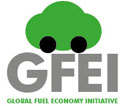
The State of Light-Duty Vehicle Fuel Economy in Egypt
1.1 Background
According to Egypt’s 2010 UNFCCC national communication, the energy intensity of the transport sector in the country is particularly high due to fuel inefficiency in road transport. The Ministry of Transport’s strategy for improving national transport and urban traffic includes the control of exhaust emissions from on-road vehicles along with improving public transport, improving energy efficiency, fuel switching, the development and use of new propulsion technologies, the development of rail transport and new methods for freight transport, the development of power train technologies, shifting from diesel to electrified railways, and the development and use of fuel cells technology. In May of 2013 the European Union announced a 123 million Euro grant for extension of Cairo’s metro and rebuilding transport infrastructure.
A GFEI assessment of auto fuel economy worldwide shows no improvement in the energy efficiency of the light duty auto fleet in the country between 2005 and 2008 – remaining at 7.3 L/100km. Additional data after 2008 are not available
1.2 Egypt Light-Duty Vehicle Fleet
Car ownership in Egypt is low by global standards at just 45 cars per 1,000 people (2009). According 2006 data, half of all motorized vehicles in Egypt operate in Greater Cairo Metropolitan Area, and 2/3 of transport sector emissions were due to urban transport. The country is motorizing quickly; however, recent political upheaval may have affected growth trends in emissions and auto ownership the trend. The automotive sector in the country has sought ways to stimulate demand for cars, including changes in the way in which income tax is levied, along with new minimum wage laws. As of 2008 there were 4.1 million licensed vehicles in Egypt, with around half of these cars operating in Greater Cairo. The sector is growing at around 5% annually and consumes about a third of the country’s refined fuel, according to a report from regional environmental NGO CEDARE. The fleet consists of significant numbers of aged vehicles, with 2008 data below showing only about 21% of vehicles in the 2000-2006 age range. This means that 79% vehicles at the time where at least 20 years old.
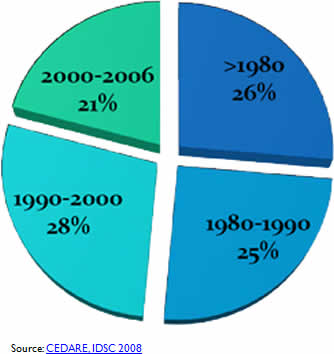
1.3 Status of LDV fleet fuel consumption/CO2 emissions
A GFEI assessment of auto fuel economy worldwide shows no improvement in the energy efficiency of the light duty auto fleet in the country between 2005 and 2008 – remaining at 7.3 L/100km. Additional data after 2008 are not available, but at the time of analysis the light duty market in the country favoured medium-seized cars, with the share of SUV’s and trucks very small compared to other countries.
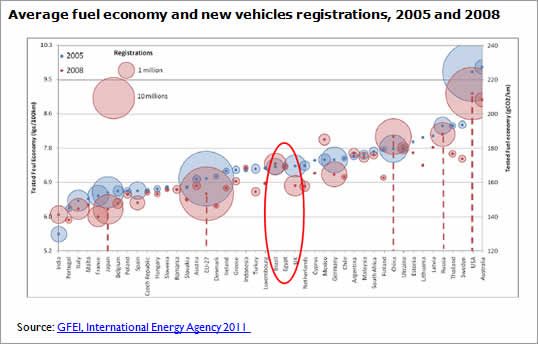
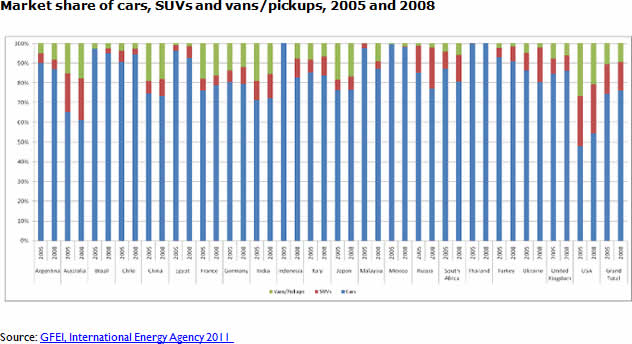
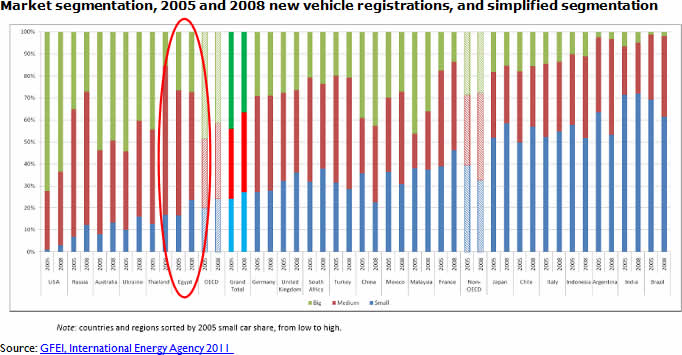
2.0 Regulatory Policies
2.1 National Standard
Egypt does not currently have an auto fuel economy standard in place, or supportive policies.
2.2 Test cycle type
None.
2.3 Import restrictions
New Vehicles
High government tariffs on completed imported cars have led to many foreign manufacturers assembling their vehicles in Egypt. Almost 40 per cent of all passenger cars sold in Egypt in 2011 were assembled locally, according to the Automotive Marketing Information Council. A list of vehicle importers is available from here.
Second Hand
All imported vehicles must be equipped with a catalytic converter; imported second-hand vehicles must be less than 3 years old.
2.4 Technology mandates/targets
N/A
3.0 Fiscal Measures and Economic Instruments
3.1 Fuel Taxes
Fuel subsidies remain high, in particular for diesel fuels.
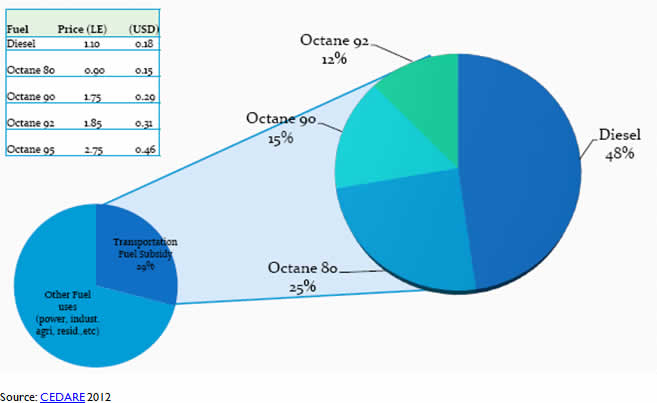
3.2 Fee-bate
None
3.3 Buy-back
A voluntary scheme to replace tax’s older than 20 years of age was launched and managed by the Ministry of Finance in 2008. The scheme was a public-private partnership and helped to improve the average auto fuel economy of the fleet to 9.39 litres/100 km for gasoline-fuelled taxi’s and 8.34 m3/100. National Traffic Law #121 of 2008 stipulated that owners of taxis older than 20 years old would not be eligible for operating licenses.
3.4 Other tax instruments
N/A
3.5 Registration fees
N/A3.6 R&D
N/A4.0 Traffic Control Measures
4.1 Priority lanes
N/A4.2 Parking
N/A4.3 Road pricing
N/A5.0 Information
5.1 Labeling
None
5.2 Public info
A group of young professionals facing long commutes and heavy congestion on a daily basis launched EgyptCarpoolers.com, which allows users to offer and request rides.
5.3 Industry reporting
N/A
The text above is a summary and synthesis of the following sources:
- Clean Technology Fund Investment Plan for Egypt. World Bank 2009. http://siteresources.worldbank.org/INTCC/Resources/CTF_Egypt_Investment_Plan_01_19_09_web.pdf
- Cleaner Fuels and Vehicles in MEWA Region. Presentation during GFEI Global Networking Event. June 2013 by Ahmed El-Dorghamy. http://www.globalfueleconomy.org/Documents/ahmed_el_dorghamy.pdf
- Egypt Autos Report Q2 2012, Market Publishers. http://pdf.marketpublishers.com/businessmonitor/egypt_autos_report_q2_2011.pdf
- Egypt 2nd National Communication to the UNFCCC. 2010. http://unfccc.int/resource/docs/natc/egync2.pdf
- Global Fuel Economy Initiative. “International comparison of light-duty vehicle
fuel economy and related characteristics.” 2011. http://www.globalfueleconomy.org/Documents/Publications/wp5_iea_fuel_Economy_report.pdf
- Gara, Tom. “ Egypt Car Industry Banks on Profit.” The Financial Times. March 5, 2012. http://www.ft.com/intl/cms/s/0/a151efb6-613b-11e1-a738-00144feabdc0.html#axzz20ylGCenw
- Syeed, Nafeesa. “A revolution to end traffic jams in Egypt.” The Christian Science Monitor. January 11, 2012. http://www.csmonitor.com/World/Global-News/2012/0111/A-revolution-to-end-traffic-jams-in-Egypt
- UNDP. Sustainable Transport PIMS 3523. http://www.undp.org.eg/Portals/0/Project%20Docs/Env_Pro%20Doc_Sustainable%20Transport.pdf
- UNEP Fuels and Vehicles Matrix, Middle East. 2008. http://new.unep.org/transport/pcfv/PDF/MatrixMENAWA-VEHSJun08.pdf
- Wikipedia, accessed on 12 July 2012, http://en.wikipedia.org/wiki/List_of_countries_by_vehicles_per_capita
- Wikipedia, accessed on 18 July 2012, http://en.wikipedia.org/wiki/Automotive_industry_by_country#Egypt
- World Bank. Data on Motor Vehicles. http://data.worldbank.org/indicator/IS.VEH.NVEH.P3
